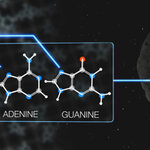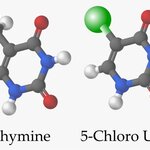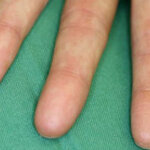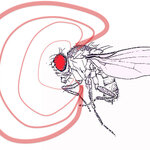Genetics & Molecular Biology

Components of DNA have been found in several meteorites ever since the 1960’s, but the question that continually lingered was whether these components were actually made in space, or rather the result of terrestrial contamination. Now, NASA-funded researchers present three lines of evidence that should support the notion that these DNA building blocks were made in space (see figure 1).
Figure 1: DNA blocks made in space?
(Source: NASA)
So, can the building blocks of life be made inside meteorites?
To investigate this question, the research team ground up samples…

René Descartes’s theory of mind-body dualism suggests the existence of a material body and an immaterial mind - parallel to one another, but capable of communication via a metaphysical LAN line.
Descartes envisioned our bodies as biological locomotives, operated by otherworldly phantoms. This concept of an immaterial realm, which somehow holds sway over the physical, is almost ubiquitous among cultures.
We humans crave explanations for what we observe, which in part gives rise to our smorgasbord of religious mythologies and elaborate metaphysical speculations. …

GM bacteria from Germany? Don’t panic, Captain Mainwaring, we’ve got it all under control!
Yes, there is indeed a lot of worry in the air, about the potential for escape of Genetically Modified organisms into the environment. Generally, this involves crop plants which have been modified to resist certain diseases, or to be immune to certain herbicides so that one can spray the crop and zap all weeds in one fell swoop.
But what if the GM organisms are bacteria? Why would one want to modify bacteria anyway? One reason might be to treat effluent and remove toxic chemicals…

Sometimes the precautionary principle can run amok. Anti-science people who don't accept climate science use it to prevent meaningful policy actions related to the environment while anti-science people who don't accept biology block efforts to improve food sources so crops can grow in areas where the world's poorest live, or improve yields to feed more people, and use silly labels like "Frankenfood."
Scientifically, food that is mutated randomly by high-energy cosmic rays is not superior just because it is 'natural', any more than shooting a tiger that wants to eat your dog is…

Imagine going through customs with everything in order. Passport’s okay, and all seems fine. But when your fingerprints are scanned, the customs agents are looking surprised. Apparently, you have no fingerprints. Sounds weird, right? And yet, it is exactly what happened to a Swiss woman in 2007 when she tried to enter the United States.
As it turned out, the woman had a very rare condition known as adermatoglyphia, leading to a lack of fingerprints (see figure 1), and a lower production of hand sweat than the average person. Very little is known about the condition, and so far, only four…

October 18, 1943 - allied forces were advancing through Nazi-held Italy. In a desperate attempt to weaken German forces occupying the village of Calvi Veccia, British infantry called in for aerial bombardment. In the last moments, British ground forces were able to capture the town, but were unable to establish radio contact to cancel the bombing. In a panic, a message was tied to the leg of a carrier pigeon named G.I. Joe. As soon as he was let loose from his cage, Joe shot into the air and bee-lined directly for HQ. He flew 20 miles in 20 minutes,…

Sheng Ding, PhD, has shown a new method for transforming adult skin cells into neurons that are capable of transmitting brain signals - one of the first documented experiments for transforming an adult human's skin cells into functioning brain cells.
Ding, of the Gladstone Institutes, said his work builds on the cell-reprogramming work of another Gladstone scientist, Senior Investigator Shinya Yamanaka, MD, PhD. Yamanaka's 2006 discovery of a way to turn adult skin cells into cells that act like embryonic stem cells has advanced the fields of cell biology and stem-cell research. …

BIOTECHNOLOGICAL IMPROVEMENT OF NEEM
Priyanka Srivastavaa, Mithilesh Singha and Rakhi Chaturvedi*a
*aDepartment of Biotechnology
Indian Institute of Technology- Guwahati
Guwahati - 781039, Assam, India
*Corresponding Author
*Department of Biotechnology
Indian Institute of Technology- Guwahati
Guwahati - 781039, Assam, India
Tel: +91-361-2582211 (off)/ 2584211 (res)
Fax: +91-361- 2582249; 2690762
Email: rakhi_chaturvedi@iitg.ernet.in
rakhi_chaturvedi@yahoo.co.uk
2
BIOTECHNOLOGICAL IMPROVEMENT OF NEEM
ABSTRACT
Azadirachta indica A. Juss or Neem (Meliaceae) is a versatile tropical, evergreen…

More than half of the world’s population, especially women and preschool children are victim of micronutrient malnutrition, primarily resulting from the consumption of diets with lower bio-available vitamins and mineral. The costs of these deficiencies in terms of lives lost and poor quality of life are shocking. To achieve the Millennium Development Goal of slashing-half the proportion of undernourished people by 2015, new technologies and approaches are needed to help address the problems. Plant breeders may tackle these problems by producing staple foods with improved bio-available…

PLANT TISSUE CULTURE AND APPLIED PLANT
BIOTECHNOLOGY
A Kumar and S Roy
Plant biotechnology, especially genetic transformation, represents one of powerful tools for the improvement of various important crops
through introduction of foreign genes into the plant genome. The present book aims at bringing out concise account of applications of plant biotechnology and role of plant tissue culture in it. The book has 4 sections. The first section deals with recent developments in use of Agrobacterium mediated gene transfer in some of the recalcitrant plant species like Mulberry, Oil palm, Cork oak…